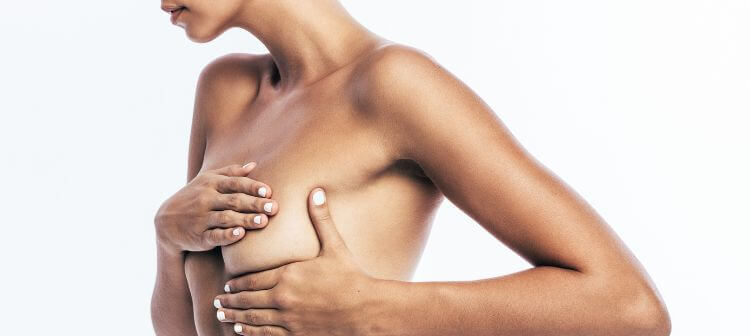Cosmetic breast surgery – whether augmentation, reduction, or uplift – is some of our most popular procedures and the same nipple-centric questions come up repeatedly in consultation or even on our social media. So, here are the answers to our most frequently asked nipple questions:
What is a nipple reduction?
Our nipples can become enlarged due to genetics, trauma, hormonal changes, pregnancy, breastfeeding, or weight fluctuations, affecting clothes choices and confidence. A nipple reduction is an aesthetic surgery to address the width and length of enlarged nipples. The areolas can also be reduced in circumference, and this procedure is often combined with a breast lift or breast reduction.
Can you make the areola smaller?
Areola reduction is a popular procedure; some women may have always been dissatisfied with the size or shape of the areola, the circle of pigmented skin surrounding the nipple. Other women have seen their areola change appearance due to massive weight loss or gain, pregnancy or breastfeeding – the tissue can become stretched, lengthened, discoloured or even raised and bumpy. Asymmetrical areola is also a common concern.
During areola reduction surgery, the skin’s shape and size are typically adjusted by removing a small area of skin in a circle around the areola to produce a more symmetrical, smaller and rounded appearance. The surrounding skin is then brought inwards and stitched to the reduced areola.
“In breast reductions, we routinely cut around the areola and adjust the size so it’s proportional to the new breast shape,” breast expert and Karidis Clinic surgeon Mr Mark Ho-Asjoe explains.
Will I lose nipple sensation after breast augmentation with implants?
Loss of nipple sensation and even numbness of the entire breast is probably the most common concern for patients contemplating breast augmentation. The loss of sensation is caused by a disruption in the nerves during surgery and can also affect breast reduction or breast lift patients.
In terms of breast augmentation though, implant size is also a factor, as a larger implant size is more likely to cause a loss of nipple sensation. Patients with a more petite frame or smaller pre-operative breasts are also more likely to be affected as the tissues must significantly stretch to accommodate the implant. Implant placement and choice of incision can also play a role.
During your consultation, all potential risks will be carefully explained to you. The good news is that, for most patients, loss of nipple sensation is temporary, and after a few weeks or months, the nerves will heal and you’ll recover normal feeling. And some patients can actually experience heightened nipple sensitivity in the recovery period.
Can you fix inverted nipples?
Inverted nipples are a prevalent condition – in fact, it’s estimated at least one in 10 people are affected. They usually occur at puberty but can become more noticeable with repeated pregnancies and breastfeeding.
The inverted nipples turn inwards because of shortened breast milk ducts, and there can be different degrees of inversion. Less severe cases of inverted nipples can be treated non-surgically, but if that fails to correct the condition, inverted nipple correction is a safe, straightforward, and highly effective cosmetic breast surgery procedure. The breast ducts are divided or separated to allow the nipple to point outward, and absorbable internal stitches are used to hold the nipple in position while healing.
“If this is a recent occurrence,” Mark explains, “then you should always visit your GP or a breast surgeon as there may be underlying pathology that must be investigated.”
Do they remove your nipples during breast lift surgery?
After weight loss, pregnancy and breastfeeding, or as a result of the ageing process, many women are left dissatisfied with the appearance of their breasts, with sagging breast tissue and nipples that point downwards.
A breast lift procedure entails reshaping the breast tissue and nipples and lifting them to a higher position on the chest wall to restore a more youthful and aesthetically pleasing appearance. Typically, the nipple is left attached to a pedicle of breast tissue which contains a blood supply that allows the nipple and areola to remain viable, and then it is moved to a more superior position without detaching it.
Can you still breastfeed after cosmetic breast surgery?
Breastfeeding after cosmetic breast surgery is often still possible, but different techniques and approaches are more likely to affect your ability to breastfeed afterwards.
“In order to breastfeed, the connection from the milk duct and the nipple has to be in continuity,” Mark explains. “When performing a breast augmentation, the implant is placed behind the glandular tissue, so breastfeeding is usually possible post-surgery.
“During a breast reduction or uplift, one of the steps we perform is to isolate the nipple and areola complex on a pedicle, which is an attachment containing its own blood and nerve supply, before moving it to a higher position to make the whole breast appear more aesthetically pleasing. This means that some of the duct is no longer connected. So typically, you will still be able to produce some milk but often this may not be sufficient.”
This is a factor to discuss with your cosmetic surgeon during your consultation and you may wish to delay surgery until after you have completed your family.
Still got questions? Call 0207 432 8727 or email enquiries@karidis.co.uk to arrange a cosmetic breast surgery consultation with Mr Mark Ho-Asjoe at the Karidis Clinic.
















